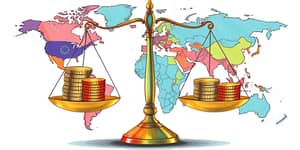
Across the globe, financial tides are shifting. The era of capital clustering primarily within Western markets is giving way to a truly polycentric financial ecosystem that spans continents. For investors, policymakers, and innovators alike, this evolution offers a wealth of opportunity to shape the future of finance and drive sustainable growth.
Today, the seamless crossing of borders and cultures in capital movement is more than a trend; it is a testament to human ingenuity and collaboration. By embracing a truly global perspective, stakeholders can harness the momentum of change and ensure prosperity for generations to come.
Historically, global capital flows were dominated by a handful of advanced economies, notably the United States and Western Europe. These regions served as both principal exporters and recipients of international investment, fostering deep but concentrated financial linkages.
However, this paradigm is transforming. Emerging hubs in Asia and the Middle East are rapidly carving out their own roles as vital destinations and sources of finance. With robust domestic demand and strategic policy initiatives, centers such as Mumbai, Dubai, and Shanghai are rewriting the playbook for cross-border investment.
This shift reflects more than new market entrants; it signifies a genuine redistribution of economic power. As sovereign wealth funds, institutional investors, and private equity firms diversify their allocations, the global economy becomes more resilient and interconnected.
At the heart of this metamorphosis lie two categories of forces. Push factors, such as prolonged low interest rates and abundant global liquidity, have historically propelled capital outward from mature markets. Yet, an equally compelling rise in pull factors is redrawing investment maps.
Countries with robust market infrastructure and regulatory certainty are now magnetizing funds. Clear legal frameworks, streamlined financial centers, and competitive tax regimes are luring global investors who seek both returns and stability.
Political stability and purpose-built free zones further amplify this advantage. Policymakers who prioritize transparency and innovation are successfully fostering dynamic investor networks and partnerships that transcend traditional barriers.
As capital flows diversify, so too do the vehicles and sectors that receive investment. While bank lending remains important, portfolio instruments such as funds, equities, and bonds are enjoying unprecedented growth. This transition underscores an increasing appetite for mobility and liquidity.
Real estate and infrastructure stand out as cornerstone domains. In the first five months of 2025, global real estate fundraising reached $58 billion, with Europe alone capturing nearly half of that sum. Meanwhile, infrastructure investments—particularly in energy transition and digital connectivity—are projected to exceed $6.5 trillion annually by mid-century.
Innovative thematic crossovers are also gaining traction. Investors are channeling resources into projects that intertwine technology and sustainability, like data centers powered by renewable energy or smart grids optimized by artificial intelligence.
While diversification unlocks new possibilities, it also introduces a layer of complexity. Portfolio flows can be highly cyclical, amplifying economic swings in both advanced and developing markets. Investors must remain vigilant to shifting interest rates, currency movements, and geopolitical undercurrents.
Moreover, rapid liberalization of capital accounts may increase vulnerability to sudden outflows. To mitigate these risks, strategic allocation and thorough due diligence are essential. Embracing active ownership strategies and value creation approaches can also enhance resilience in volatile conditions.
Pragmatic guidance can illuminate the path forward:
We stand at a pivotal juncture. The global financial tapestry is being rewoven to reflect a more equitable and interconnected world. By recognizing the power of diversification, investors and policymakers can co-create a system that is both robust and adaptable.
Let us seize this moment to champion innovation, uphold transparency, and foster collaboration across borders. In doing so, we not only safeguard our capital but also fuel the collective prosperity that defines our shared human story.
References













